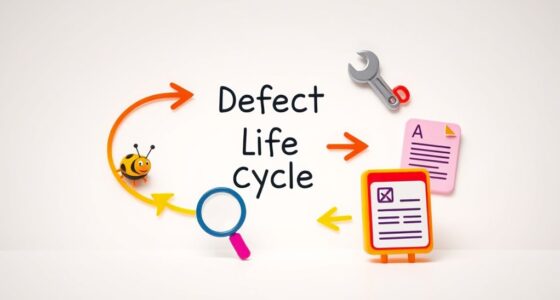Managing test data on a tight budget is doable by using synthetic data generation and data masking tools that are free or low-cost. Focus on automating these processes to reduce errors and save time. Store your datasets centrally to enable quick access and reuse across testing cycles. Evaluate your existing data to determine what needs masking or synthetic creation, helping you avoid costly new datasets. Keep an eye on these strategies to learn more about effective, budget-friendly testing techniques.
Key Takeaways
- Utilize open-source tools or simple scripts to generate synthetic data mimicking real datasets.
- Implement data masking techniques to convert sensitive production data into safe testing versions.
- Automate data masking and synthetic data creation to reduce manual effort and human error.
- Store and organize datasets centrally to enable quick access and reusability across testing cycles.
- Evaluate existing data to determine the most cost-effective approach—masking or synthetic data generation—saving resources.

Effective test data management is essential for ensuring your software testing processes are accurate and efficient. When working with limited resources, leveraging cost-effective strategies becomes even more critical. One of the most powerful approaches you can adopt is using synthetic data. Synthetic data is artificially generated to resemble real data without exposing sensitive information, making it ideal for testing environments where privacy concerns are paramount. You can create this data using open-source tools or simple scripts, reducing reliance on expensive data sets or complex data extraction processes. Synthetic data allows you to test various scenarios, edge cases, and system behaviors without risking data breaches or privacy violations, all on a shoestring budget.
Alongside synthetic data, data masking plays an essential role in managing test data cost-effectively. Data masking involves transforming real data into a version that maintains its format and usability but conceals sensitive information like personal identifiers, financial details, or health records. This technique enables you to reuse actual production data safely in testing environments without incurring additional costs for data anonymization or outsourcing. By masking data in-house, you save on licensing fees or third-party services, making it a budget-friendly solution. Plus, data masking helps you comply with privacy regulations, ensuring that your testing activities remain within legal boundaries.
To maximize your limited resources, start by evaluating your existing data and identifying what needs to be masked or replaced with synthetic data. Automate these processes where possible, using free or low-cost tools to generate synthetic datasets or apply data masking routines. This automation not only saves time but also minimizes human error, increasing the reliability of your test data. Additionally, consider implementing a data management strategy that emphasizes reusability. Store masked and synthetic datasets in a centralized location, allowing your team to access them as needed for different testing cycles. This approach reduces the need to generate new data from scratch each time, saving both time and money. Incorporating proper data organization can further enhance efficiency and ensure quick retrieval of test datasets when needed.
Frequently Asked Questions
How Can Small Teams Effectively Manage Test Data Costs?
You can manage test data costs effectively by implementing data anonymization to protect sensitive info without extra expenses. Use test data archiving to reuse datasets, reducing the need for frequent new data creation. Automate these processes to save time and resources, and prioritize key testing scenarios. This approach helps small teams stay within budget while maintaining data security and quality, ensuring smooth testing without overspending.
What Free Tools Are Available for Test Data Management?
Imagine your testing environment as a vibrant, bustling marketplace where data flows freely. You can harness free tools like open-source data masking solutions and test data virtualization platforms to protect sensitive info and simulate real-world scenarios. These tools act like invisible fences, keeping data secure while giving you access to diverse datasets. Embrace these resources to streamline your testing process without breaking the bank, making your data management both efficient and cost-effective.
How to Ensure Data Privacy Without Expensive Solutions?
To guarantee data privacy without costly solutions, focus on data anonymization, removing or masking sensitive info to protect identities. Implement strong access controls, granting permissions only to essential users, and regularly review these rights. Use free tools like open-source anonymization scripts and access management solutions. By combining data anonymization with strict access controls, you can safeguard privacy effectively and cheaply, even on a tight budget.
Can Open-Source Software Replace Commercial Test Data Tools?
Did you know 78% of organizations use open-source software? Open-source alternatives can definitely replace commercial test data tools, especially when you’re on a tight budget. They offer customizable, budget-friendly strategies that help you manage test data effectively without sacrificing quality. While they may need more setup, open-source tools can provide the flexibility and cost savings you need to keep testing robust and secure without big expenses.
What Are Low-Cost Strategies for Maintaining Test Data Quality?
To maintain test data quality cost-effectively, you should prioritize regular test data refresh to keep data relevant. Implement data masking techniques to protect sensitive information without extra expenses. Automate data refresh and masking processes where possible, reducing manual effort and errors. These strategies ensure your test data remains accurate, secure, and up-to-date, helping you maximize quality without overspending.
Conclusion
Remember, a penny saved is a penny earned. With smart planning and creative solutions, you can manage test data effectively even on a shoestring budget. Leverage open-source tools, automate where possible, and prioritize your most critical testing needs. By doing so, you’ll turn a tight budget into a strategic advantage. Keep in mind, the best things in life—and in testing—often come from making the most of what you already have.
Randy serves as our Software Quality Assurance Expert, bringing to the table a rich tapestry of industry experiences gathered over 15 years with various renowned tech companies. His deep understanding of the intricate aspects and the evolving challenges in SQA is unparalleled. At EarnQA, Randy’s contributions extend well beyond developing courses; he is a mentor to students and a leader of webinars, sharing valuable insights and hands-on experiences that greatly enhance our educational programs.










